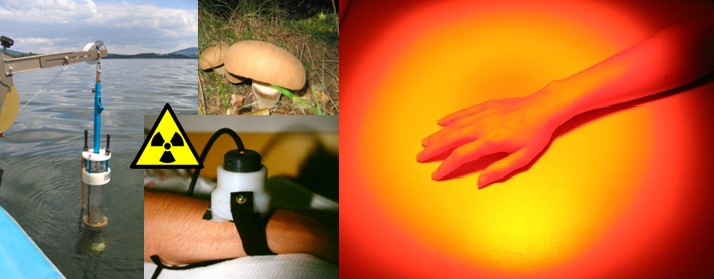
The Environmental Biophysics group at the University Salzburg is strongly interdisciplinary oriented. Initially the group started with radon research in 1972 with appointing the professorship of physics at the newly founded faculty of Natural Sciences. The physics group carried out research on radon measurement techniques, radiation biology and the development of a deposition model of radon decay products in the human lung, which opened a valuable connection to aerosol physics.
After the catastrophic reactor accident in Chernobyl, the research field was situationally expanded towards environmental radioactivity and radioecology, as know-how and instrumentation were already available in the laboratory.
Currently, the interdisciplinary team can be divided into two research groups:
- Environmental radioactivity, radon research and aerosol physics and Biophotonics
The group is working on the behaviour of radionuclides in the biosphere and long-term transfer and enrichment processes. A major contribution to these activities is a close cooperation with the provincial government of Salzburg to run the Radiological Measurement Laboratory of Salzburg (RMLS). The RMLS fulfils a wide spectrum of duties such as radioactivity measurements of environmental samples, training of experts, maintenance of operational readiness for a radiological emergency and implementation of national and international research projects on safety aspects and environmental radioactivity.
We are also interested on the behaviour of radon and radon decay products in the lung tissue and on the skin. The group has expertise on the measurement, modelling and dosimetry of aerosols.
The common denominator of the different research topics studied by the aerosol biophysics group in recent years is the development of computational models for the deposition of inhaled aerosols in the human lung. These aerosols cover a wide range of solid particles and droplets, including radioactive aerosols, such as radon progeny, traffic-related and industrial aerosols, such as car emissions, therapeutic aerosols, such as asthma sprays, and environmental and mainstream tobacco aerosols, such as combustible and electronic cigarettes. The primary objective of all these simulations is the determination of the resulting deposition patterns to be related to site-specific health effects in the lungs, primarily bronchial carcinomas.
Almost a century ago the study of non-ionizing electromagnetic emissions from biological samples was acknowledged for the first time. Yet it took another half a century to systematically study this phenomenon with appropriate detection devices such as the photo-multiplier-tube (PMT) technology. As a result of an international meeting on bio- communication in 2007, a small sub-group within the RMLS initiated a range-extension to encompass the non-ionizing part of the electromagnetic spectrum. In 2010, these efforts gained further momentum with the presentation of the technological approach. Three years later it was successfully implemented within the framework of EU-FP7 to target biophotonic emissions as a result of airborne nano-particle interaction. This range-extension into the spectral range below UV enables us not only to investigate ultra-weak emission from living samples but at the same time provide us with powerful tools to study biophysical properties in living matter and how these affect biochemistry in the living system.
- The Laboratory of Photodynamic Inactivation of Microorganisms (PDI-PLUS)
The global rise of microorganisms resistant to treatment with conventional antibiotics poses a threat to humans. If not tackled immediately antibiotic resistance will have killed 300 million people by 2050. Therefore, the rapid development of new antimicrobial approaches is urged by health agencies such as the WHO. Photodynamic Inactivation (PDI) combines two per se harmless components: in a first treatment step, a light sensitive substance (the photosensitizer) is applied to the infected area and rapidly accumulates in microorganisms. After very short incubation the photosensitizer is activated with visible light. This induces the formation of reactive oxygen molecules that kill the microorganisms irrespective of their susceptibility to conventional antibiotics. Due to the very unspecific method of action, the development of resistance of microorganisms against PDI is very unlikely.
Since 2010, the Laboratory of Photodynamic Inactivation (PDI-PLUS) focuses on research on this antimicrobial approach with the claim to mature the procedure for application in human medicine, food safety and plant protection. Our lab has gained world-wide acknowledgement for its expertise in using natural substances (some of which are approved as food additives) as photosensitizers.
For further information, please visit www.uni-salzburg.at/pd





